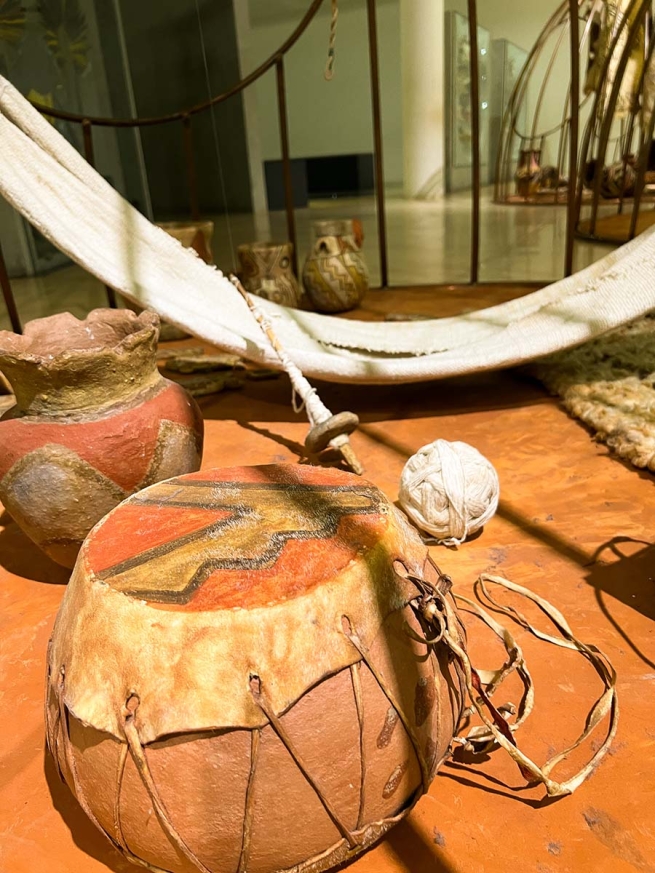A museum – said Fr Alfred Maravilla, Councillor in charge of the Sector – is a non-profit institution at the service of society that researches, collects, preserves, interprets and exhibits material and intangible finds. Open to the public, accessible and inclusive, museums encourage diversity and sustainability. Specifically, Fr Maraviglia, stressed, Salesian missionary museums pay attention to the original culture of indigenous peoples and encourage intercultural awareness in young people, helping them to grow in mutual respect of peoples and in the discovery of the other.
But where and what are these museums? One tour is enough to trigger the curiosity of enthusiasts. Looking at the Italian area and in particular Piedmont, we find the Missionary Ethnological Museum at Colle Don Bosco, built in 1942, and the Museum of Natural History started in 1878 and developed around the school at the Turin Institute in Valsalice.
Salesian Europe offers an exhibition of some museum collections in Lisbon, Portugal, at the Provincial House, and in Madrid, at the Mission Office, dedicated mainly to African culture as well as to the history of some missionaries.
Still in Europe, some works should be noted among others that, despite not having particular exhibitions, represent great artistic and historical value, such as the Benedictine Monastery in Ensdorf, active from 1121 to 1802; the Benediktbeuren Abbey, in Germany, an hour by train from Munich. The Baroque-style building dominates the lake by the same name with its rich fauna and flora, recently restored with works suitable for the teaching of Ecology. Also worth remembering and visiting is the Polish Mother House in Oswiecim with the Shrine of Mary Help of Christians.
In Latin America, where Don Bosco's charism has been widely sown, there are a number of museums and collections that are stimulating for their anthropological, ethnographic and historical value. The Vicente Rasetto museum began in 1977 museum in Huancayo, Peru. In Ecuador, in Quito, we find the Abya Yala Museum. Opened in 1957, today it has drawn the attention of UNESCO and Ethnological Research Centres. The power behind it has been Cuneo-born Fr Juan Botasso, especially for editorial production. Today it is directed by Nataly del Pilar who, participating in the conference of Salesian missionary museums, among other things, hoped for a networking of the entire Salesian museography.
In Chile, it is worth noting the recent reopening of the Museum dedicated to Cardinal Raul Silva Henriquez and the presence in the South of the important Maggiorino Borgatello museum, with the history of the Mapuche Indians and other tribes. In Puerto Ayacucho, Venezuela, there is the Monsignor Ceccarelli museum.
Of note are the museum presences in Argentina and Brazil. In Argentina, we can consult the rich archives and documents of the historian Fr Gaetano Bruno, and not only that, we find the Regional Museum of Rawson, in the province of Chubut, with pre-Columbian collections and a collection of over 500 ceramics belonging to the native peoples. In San Nicolás de Los Arroyos you can visit the Antonio Scasso Museum and in San Josè the one wanted by the Gentilini Family concerning the agricultural school. A must-see in Patagonia is the Historical and Natural Museum dedicated to the bishop and explorer Bishop Giuseppe Fagnano, which began in 1913. Here you can learn about the work of the first Salesian missionaries, with Alberto De Agostini among them, who were able to combine evangelisation and culture.
Brazil offers two valuable opportunities. One is in São Paulo, at the Provincial House, dedicated to Salesian history in that country, and the other in Campo Grande. The latter is of interest to UNESCO and among other things has also received the issuance of a stamp on the occasion of its seventieth anniversary. Fr Cesare Albisetti, the indigenous Bororo Tiago Marques, Fr Angelo Venturelli ("the one who managed to transform the manuscripts of Fr Albisetti into what is now the Bororo Encyclopedia"), Fr Felice Zavattaro and Fr João Falco, who stamped his own character on the museum.
From Brazil, where St John Bosco has the most beautiful church dedicated to him in the capital Brasilia, we return to Turin, where we cannot fail to mention the renovated Casa Don Bosco Museum in Valdocco. Here an entire building was redevloped under the direction of architects Sergio Sabbadini and Massimo Chiappetta: a total area of about 4,000 square metres and 27 exhibition spaces. The strong conservative restoration has led to the discovery of spaces where Don Bosco, Mamma Margaret, Fr Rua operated in the early days of the Oratory in continuity with the little room where the Saint flew to heaven.
"Here, in these environments" said Cardinal and Rector Major, Ángel Fernández Artime, who strongly wanted the renovation of these spaces "a pedagogy was born that changed the lives of Don Bosco's boys; eleven people have passed through here who today the Church recognizes as Venerable, Blessed and Saint: this means that Valdocco has been a school of humanity and holiness and we want to pass on this heritage to the world." And yet in this Museum, the Rector Major continues, "there are not only Salesians, but many past pupils of incredible social ability, some martyrs who have marked these ideals with their lives and blood, many consecrated and lay women."
The Museum ha Dr. Ana Martín García as director and a team of volunteer guides ready to accompany the ever-increasing number of visitors. In reality, visiting these environments with their mix of objects and religious art, paintings and maps, statues, writings and various collections gives you the feeling of encountering not a past memory, but the events of a current charism.
Fr Giuseppe Costa,
Co-spokesperson of the Salesian Congregation


